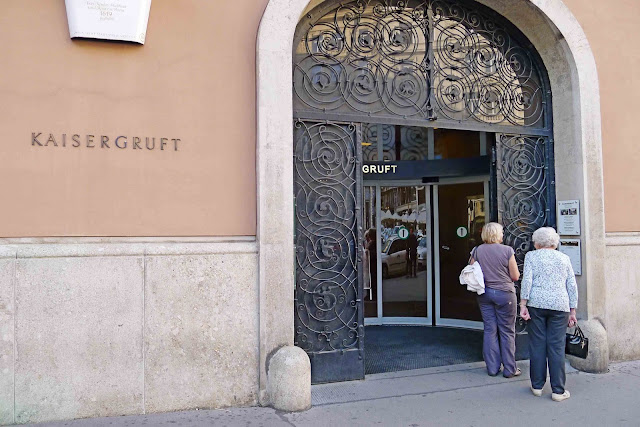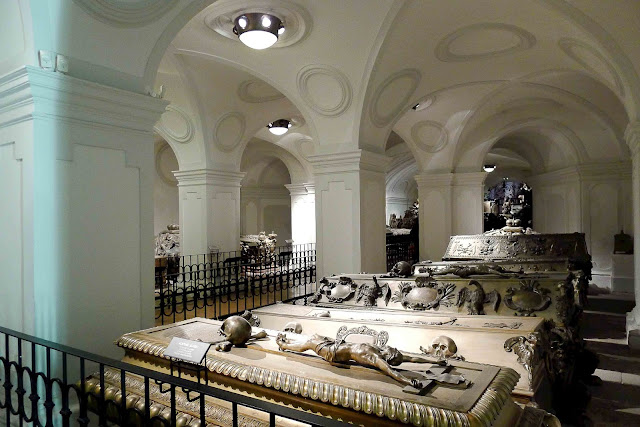Habsburg Imperial Crypt - And The Viennese Death Culture
I am a HUGE fan of Cathedrals, Burial Places, and Cathedral-Crypts!
So when I read in several guide books that there was an Imperial Crypt full of Monarchs from the Holy Roman Empire, as well as members of the House of Habsburg, I just knew that we had to check it out!
* The unassuming entrance to the Crypt below. You wouldn't be able to tell at all that 12 Holy Roman Emperors and 18 Empresses are actually entombed here!
* Built in 1633, the Imperial Crypt has been the burial place for family members of the House of Habsburg for Centuries.
* The sarcophagi are placed and marked along a series of ten interconnected subterranean vaulted rooms.
* All in all, 145 members of the House of Habsburg are buried here, including the aforementioned 12 Emperors and 18 Empresses. A quarter of those entombed here were under 5 years old when they died.
* And since pretty much all of Europe (save for France, Scandinavia, and England) was once under the Habsburgs, you can definitely say that this is the final resting place for some of Europe's most powerful people.
* We were able to take loads of pics as there were so few people down there with us that day. Well, people who are living, that is!
* Looks like everyone here competed to have the most extravagant and ostentatious sarcophagus!
* The Sarcophagus of Kaiser Joseph I, who was King of Germany, Hungary, Bohemia (Czech Republic) and Holy Roman Emperor.
* The Sarcophagus of Charles VI, who was the younger brother of Joseph I. The skull on the left depicts a death's head wearing the Imperial Crown of the Holy Roman Empire.
* The Viennese people have a great fascination with death, with cemeteries being popular hang-outs and strolling grounds, and grand tombs being an indication of wealth and class.
* In fact, there exists insurance agencies called Sterbevereine, who provide applicants with opportunities to save up for a nice funeral throughout their lives.
* Musically, the Viennese people are also huge fans of highly sentimental music, with lyrics playing around the theme of death.
* The biggest and most grand of all the sarcophagi is most definitely that of Empress Maria Theresa.
* Reigning for 40 years, the Empress lived through a series of conflicts which afflicted the Empire: The War of Austrian Succession and the Seven Years' War.
* Apart from her contributions and reputation for having lived through a critical time period in European history, the Empress is also famous for giving birth to sixteen children, of which the youngest daughter would grow up to become the Queen of France, the infamous Marie Antoinette.
* A look back on the main subterranean vault. Everything is eerily beautiful.
* The writer having the time of his life; his wife half-enjoying, half-freaked out.
* And the Crypt continues to be used today with the most recent entombment occurring in 2011 for Otto Von Habsburg, the last Crown Prince of the Austro-Hungarian Empire.
* The hardworking people tasked with maintaining and safeguarding the Crypt are members of the Capuchin Friar Order, housed in the Church on top of the vaults.
* The unassuming (well compared to the others) sarcophagus of Leopold Wilhelm, Archduke of Austria and Governor of the Spanish Netherlands, who was an avid patron of the arts.
* Among the more contemporary Habsburgs entombed here are Franz Joseph I, Emperor of Austria, King of Hungary, Croatia and Bohemia. It was the assassination of his presumptive heir, Archduke Franz Ferdinand, that resulted in Austria-Hungary's declaration of war against the Kingdom of Serbia, leading to World War I.
* Franz Joseph I's wife, Empress Elisabeth of Austria (fondly called Sisi), was once hailed as one of Europe's most beautiful women.

* On top of the Crypt is the Capuchin Church, where the bodies of Habsburg monarchs lie in repose before being entombed below.

* And the most precious work of art in the Church is this Pieta by Peter Strudel, near the altar.


























Comments
Post a Comment